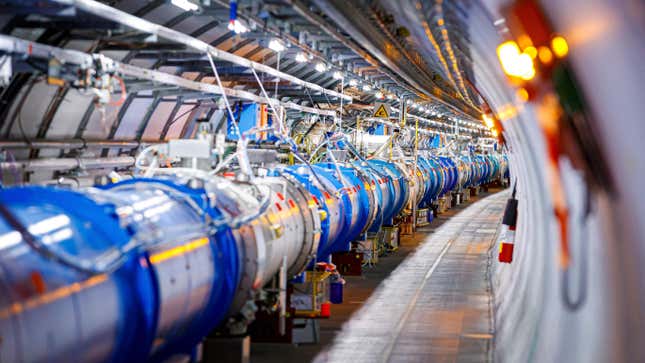
Researchers at CERN’s Large Hadron Collider in Switzerland recently detected a vanishingly rare particle they believe was around at the very beginning of the universe. The particle—called an X particle for now, because no one knows exactly what it is—was produced by colliding billions of heavy ions inside the famous particle accelerator.
The team with the CMS Collaboration, which collects data from the LHC’s Compact Muon Solenoid, smashed heavy lead atoms together at temperatures of around 5.5 trillion degrees Celsius (9.9 trillion degrees Fahrenheit). The team’s results are published in Physical Review Letters.
Physicists theorize that, in the earliest moments of the universe after the Big Bang, matter was a plasma made of subatomic quarks and gluons crammed together in a superheated soup. (Only when the plasma cooled down several microseconds after the Big Bang did the familiar protons and neutrons take shape, paving the way for much more massive forms of matter.) But before the material cooled down, some of those quarks and gluons collided, forming more enigmatic particles, which physicists call X particles.
X particles are rare today because the universe is no longer so dense nor so hot, but as Krishna Rajagopal, a particle physicist at MIT who is unaffiliated with the recent research, said in 2010: “If you’re interested in the properties of the microseconds-old universe, the best way to study it is not by building a telescope, it’s by building an accelerator.”
The team was able to identify 100 X particles of a specific mass, called X(3872), that survived for about one-sextillionth of a second before decaying. X(3872) was first found in 2003 by the Belle Collaboration via bump hunting, which is when researchers identify an unexpected amount of mass or energy in their system.
“The X(3872) is a strange animal,” said Patrick Koppenburg, physicist at the Dutch National Institute for Subatomic Physics and a member of the LHCb team at CERN, in an email to Gizmodo. “I was at Belle when it was discovered, and I remember that we stared at the little bump without understanding what was going on.”

Last year, Koppenburg’s team at LHCb discovered a new species of tetraquark. Like X(3872), that tetraquark had a fleeting lifespan—probably just over one-quintillionth of a second. Though other exotic particles turn up and vanish at the LHC, X(3872) is the first X particle detected in the quark-gluon plasma generated there.
The team behind the new study was able to mimic the conditions of the early universe by accelerating 13 billion ions. When the particles collided, they produced thousands of short-lived charged particles. Yen-Jie Lee, a physicist at MIT and a co-author of the new research, told Gizmodo that it’s possible other X particles may be in the recent data, but the researchers didn’t have a good way of picking them out from the background noise.
“The first heavy-ion in ‘Run 3’ is starting at the end of this year, and we hope to accumulate more data with the lead-lead collision runs in Run 3 and Run 4,” Lee wrote in an email. “With a much larger dataset, we will be able to pin down the size of enhancement of X production in the quark soup and gain more insights about its internal structure.”
The identity of X(3872) is still uncertain. The team thinks that the particle could be a type of loosely bound mesonic molecule (two subatomic particles called mesons bound via the strong force) or a tetraquark, a type of hadron composed of four quarks glommed together. “So far, the mesonic molecules are not yet definitively observed, and X(3872) is a good candidate,” said Jing Wang, a physicist at MIT who led the analysis of the new data, in an email to Gizmodo. “If X(3872) turns out to be a mesonic molecule, we show that in the early universe, there must be different kinds of mesonic molecules in addition to the ordinary hadrons.”
“The more I look at the data, the more I am convinced that the X is a superposition of a molecule and a charmonium state,” Koppenburg said. Describing the idea of superposition further, he noted: “Our brain fails to represent these things. ... There’s no such thing as one or the other in quantum mechanics. If you cannot tell two things apart, then the truth must be both simultaneously.”
Perhaps the upcoming runs of the LHC will finally resolve the identity of X(3872). Of course, then it would have an actual name, and won’t be considered an X particle anymore.
More: CERN Physicists Have Discovered a Batch of New Exotic Particles